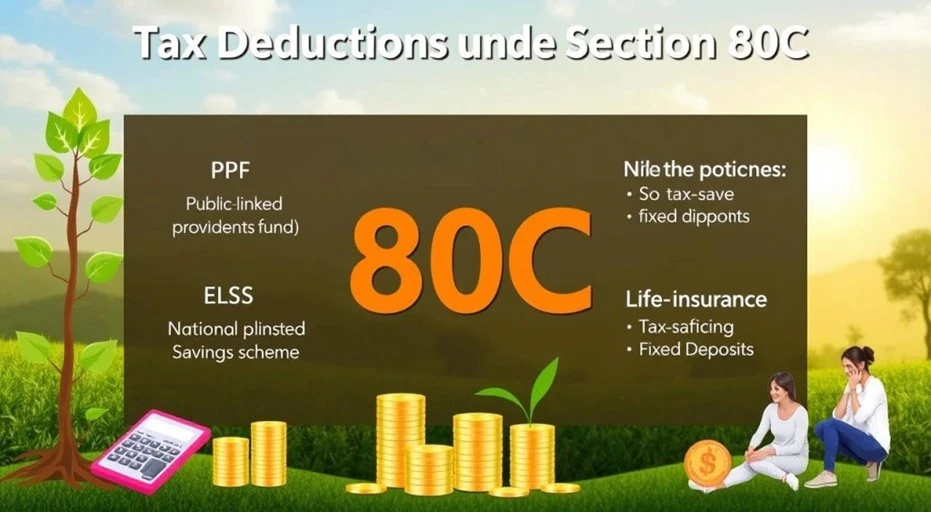Section 80C of the Income Tax Act, 1961, is one of the most popular tax-saving provisions for individuals and Hindu Undivided Families (HUFs) in India. It allows taxpayers to reduce their taxable income by up to ₹1.5 lakh per financial year by investing in specified financial instruments. Apart from lowering tax liability, these investments can also contribute to long-term wealth creation.
Key Points at a Glance
- Maximum deduction limit: ₹1.5 lakh per year.
- Eligible for both residents and NRIs (for certain instruments).
- Covers a variety of investments such as Life Insurance, PPF, ELSS, NSC, and tax-saving FDs.
- Additional ₹50,000 deduction available for NPS under Section 80CCD(1B).
- Applicable to individuals and HUFs, not to companies or partnerships.
Who Can Claim Section 80C Deductions?
Any individual taxpayer or HUF can claim deductions under Section 80C. Corporate bodies, partnerships, and LLPs are not eligible. Both resident and eligible non-resident taxpayers can use these benefits. There is no age limit, and certain expenses—like tuition fees for up to two children—are also covered.
Major Investments and Expenses Covered Under Section 80C
- Life Insurance Premiums
- Premiums paid for policies from LIC or other approved insurers qualify.
- Deduction available for self, spouse, and children (dependent or independent).
- Premiums must not exceed 10% of the sum assured for the deduction to apply.
- Public Provident Fund (PPF)
- Annual investment limit: ₹500 (minimum) to ₹1.5 lakh (maximum).
- Current interest rate: ~7%–8% (tax-free).
- Lock-in: 15 years (with partial withdrawals allowed after 5 years).
- Equity Linked Savings Scheme (ELSS)
- Market-linked mutual funds with tax benefits.
- Lock-in: 3 years (shortest among 80C options).
- Potential returns: 12%–15% (market-dependent).
- National Savings Certificate (NSC)
- Fixed-income instrument issued by post offices.
- Lock-in: 5 years.
- Interest is taxable, but reinvested interest (except in the final year) also qualifies for 80C deduction.
- Tax-Saving Fixed Deposits
- Offered by banks with a fixed 5-year lock-in.
- Interest is taxable.
- Minimum investment ₹10,000 (varies by bank).
- Pension Fund Contributions (Section 80CCC)
- Premiums paid for certain pension funds qualify.
- Limit included within the overall ₹1.5 lakh cap.
- National Pension System (NPS) Contributions (Section 80CCD)
- Deduction under 80C for employer/employee contributions.
- Additional ₹50,000 deduction under Section 80CCD(1B) beyond the ₹1.5 lakh limit.
- Other Eligible Options
- Sukanya Samriddhi Yojana deposits.
- Senior Citizens Savings Scheme (SCSS).
- Five-year post office time deposits.
- Tuition fees for up to two children (excluding donations or development fees).
Lock-in Periods at a Glance
- ELSS: 3 years.
- PPF: 15 years.
- NSC: 5 years.
- Tax-saving FD: 5 years.
- NPS: Until retirement.
Common Mistakes to Avoid
- Making last-minute investments without planning.
- Failing to keep proper investment proofs.
- Claiming for ineligible expenses or exceeding the allowed premium percentage for life insurance.
- Mismatching investment records with Form 26AS.
Why Section 80C is a Financial Planning Essential
Strategically using Section 80C deductions can reduce your tax burden while building a disciplined savings habit. Spreading investments across market-linked and fixed-income options ensures both growth and stability. Additionally, topping up with NPS contributions can push your total tax deduction to ₹2 lakh annually.
